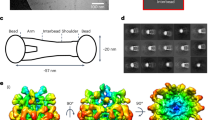Abstract
Extracellular elastic fibres provide mechanical elasticity to tissues and contribute towards the processes of organ remodelling by affecting cell–cell signalling1,2. The formation of elastic fibres requires the assembly and crosslinking of tropoelastin monomers, and organization of the resulting insoluble elastin matrix into functional fibres. The molecules and mechanisms involved in this process are unknown. Fibulin-5 (also known as EVEC/DANCE) is an extracellular matrix protein abundantly expressed in great vessels and cardiac valves during embryogenesis, and in many adult tissues including the aorta, lung, uterus and skin, all of which contain abundant elastic fibres3,4. Here we show that fibulin-5 is a calcium-dependent, elastin-binding protein that localizes to the surface of elastic fibres in vivo. fibulin-5-/- mice develop marked elastinopathy owing to the disorganization of elastic fibres, with resulting loose skin, vascular abnormalities and emphysematous lung. This phenotype, which resembles the cutis laxa syndrome in humans5, reveals a critical function for fibulin-5 as a scaffold protein that organizes and links elastic fibres to cells. This function may be mediated by the RGD motif in fibulin-5, which binds to cell surface integrins, and the Ca2+-binding epidermal growth factor (EGF) repeats, which bind elastin.
This is a preview of subscription content, access via your institution
Access options
Subscribe to this journal
Receive 51 print issues and online access
$199.00 per year
only $3.90 per issue
Buy this article
- Purchase on SpringerLink
- Instant access to full article PDF
Prices may be subject to local taxes which are calculated during checkout




Similar content being viewed by others
References
Mecham, R. P. & Davis, E. C. in Extracellular Matrix Assembly and Structure (eds Yurchenco, P. D., Birk, D. E. & Mecham, R. P.) 281–314 (Academic, New York, 1994).
Li, D. Y. et al. Elastin is an essential determinant of arterial morphogenesis. Nature 393, 276–280 (1998).
Kowal, R. C., Richardson, J. A., Miano, J. M. & Olson, E. N. EVEC, a novel epidermal growth factor-like repeat-containing protein upregulated in embryonic and diseased adult vasculature. Circ. Res. 84, 1166–1176 (1999).
Nakamura, T. et al. DANCE, a novel secreted RGD protein expressed in developing, atherosclerotic, and balloon-injured arteries. J. Biol. Chem. 274, 22476–22483 (1999).
Milewicz, D. M., Urban, Z. & Boyd, C. Genetic disorders of the elastic fiber system. Matrix Biol. 19, 471–480 (2000).
Sasaki, T. et al. Tropoelastin binding to fibulins, nidogen-2 and other extracellular matrix proteins. FEBS Lett. 460, 280–284 (1999).
Doliana, R. et al. EMILIN, a component of the elastic fiber and a new member of the C1q/tumor necrosis factor superfamily of proteins. J. Biol. Chem. 274, 16773–16781 (1999).
Trask, B. C. et al. Posttranslational modifications of microfibril assocoated glycoprotein-1. Biochemistry 40, 4372–4380 (2001).
Trask, T. M. et al. Interaction of tropoelastin with the amino-terminal domains of fibrillin-1 and fibrillin-2 suggests a role for the fibrillins in elastic fiber assembly. J. Biol. Chem. 275, 24400–24406 (2000).
Pereira, L. et al. Targeting of the gene encoding fibrillin-1 recapitulates the vascular aspect of Marfan syndrome. Nature Genet. 17, 218–222 (1997).
Pereira, L. et al. Pathogenetic sequence for aneurysm revealed in mice underexpressing fibrillin-1. Proc. Natl Acad. Sci. USA 96, 3819–3823 (1997).
Chaudhry, S. S. et al. Mutation of the gene encoding fibrillin-2 results in syndactyly in mice. Hum. Mol. Genet. 10, 835–843 (2001).
Arteaga-Solis, E. et al. Regulation of limb patterning by extracellular microfibrils. J. Cell Biol. 154, 275–281 (2001).
Starcher, B. & Conrad, M. A role for neutrophil elastase in the progression of solar elastosis. Connect. Tissue Res. 31, 133–140 (1995).
Davis, E. C. Smooth muscle cell to elastic lamina connections in the developing mouse aorta: role in aortic medial organization. Lab. Invest. 68, 89–99 (1993).
Davis, E. C. Immunolocalization of microfibril and microfibril-associated proteins in the subendothelial matrix of the developing mouse aorta. J. Cell Sci. 107, 727–736 (1994).
Reinhardt, D. P. et al. Fibrillin-1: organization in microfibrils and structural properties. J. Mol. Biol. 258, 104–116 (1996).
Reinhardt, D. P. et al. Fibrillin-1 and fibulin-2 interact and are colocalized in some tissues. J. Biol. Chem. 271, 19489–19496 (1996).
Acknowledgements
We thank R. Kowal and B. Abrams for reagents. We thank J. Shelton, J. Stark, S. Yokoyama and A. Rankin for technical assistance, A. Tizenor for graphic assistance, and M. Brown for critical reading of the manuscript. This work was supported in part by the American Heart Association (H.Y.), National Institutes of Health (E.C.D. and E.N.O.) and the D.W. Reynolds Foundation for Clinical Cardiovascular Research (E.N.O.). M.Y. is an investigator for the Howard Hughes Medical Institutes.
Author information
Authors and Affiliations
Corresponding author
Ethics declarations
Competing interests
The authors declare no competing financial interests.
Rights and permissions
About this article
Cite this article
Yanagisawa, H., Davis, E., Starcher, B. et al. Fibulin-5 is an elastin-binding protein essential for elastic fibre development in vivo. Nature 415, 168–171 (2002). https://doi.org/10.1038/415168a
Received:
Accepted:
Issue Date:
DOI: https://doi.org/10.1038/415168a
This article is cited by
-
Genetics and mechanisms of thoracic aortic disease
Nature Reviews Cardiology (2023)
-
Integrated analysis of lncRNAs and mRNAs by RNA-Seq in secondary hair follicle development and cycling (anagen, catagen and telogen) of Jiangnan cashmere goat (Capra hircus)
BMC Veterinary Research (2022)
-
A mechanistic view on the aging human skin through ex vivo layer-by-layer analysis of mechanics and microstructure of facial and mammary dermis
Scientific Reports (2022)
-
Mouse Knockout Models for Pelvic Organ Prolapse: a Systematic Review
International Urogynecology Journal (2022)
-
Mesenchymal stem cell transplantation for vaginal repair in an ovariectomized rhesus macaque model
Stem Cell Research & Therapy (2021)




